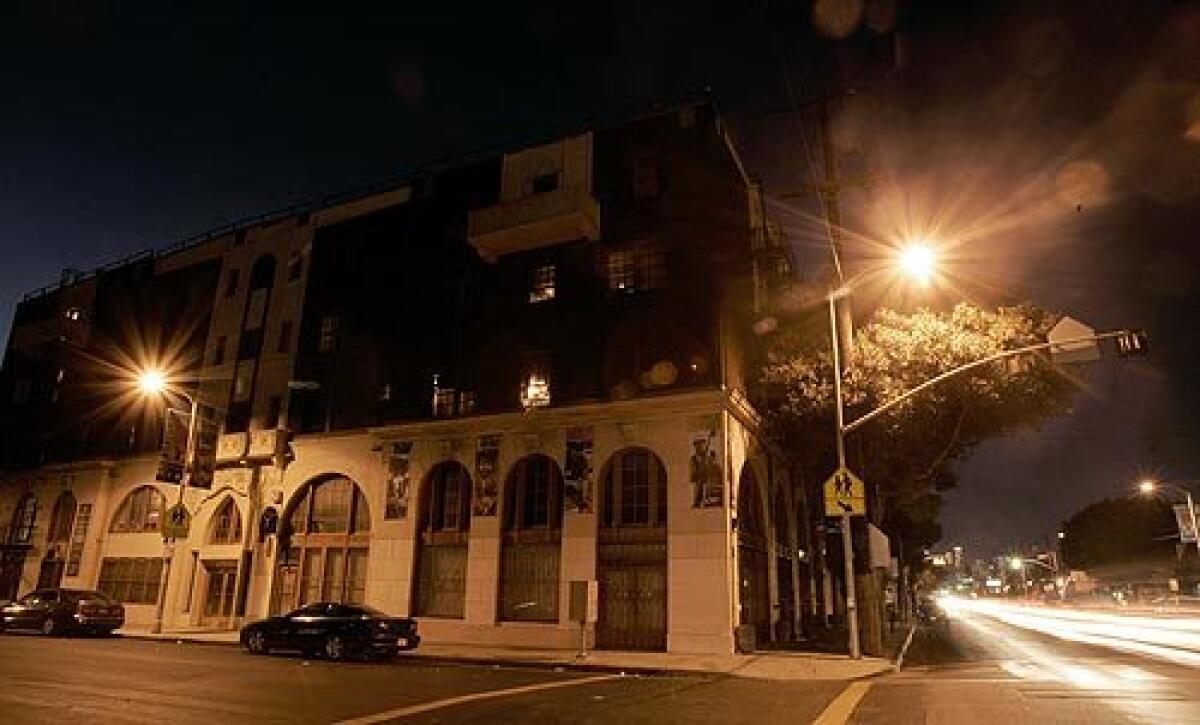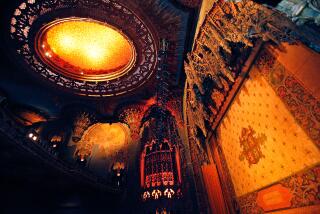The Dunbar in South L.A., once a landmark, has lost its beat

In 1957, Jimmy Steward graduated from high school in El Dorado, Ark., which had piney woods and pretty promenades left over from an oil boom, but no jobs to speak of. Like many others, he looked west for work, and landed in South Los Angeles, where, like many others, “I didn’t find no gold.”
Steward worked in warehouses and foundries and eventually took a one-room apartment on Central Avenue, in a tired building where the ghosts are named Basie, Calloway and Ellington, and where the walls, if they could talk, might break into song.
Steward is one of 32 people who live in the Dunbar Hotel, in a strange netherworld -- which City Hall, for better or worse, will soon take ownership of because the hotel has failed to repay nearly $3 million in loans.
On the one hand, the Dunbar is a monument to the strength and guts of black L.A.
Financed by black business leaders, built by black craftsmen and opened in 1928 along the spine of the black community, it was a source of great pride in an age of segregation. It became the epicenter of West Coast jazz, and its guest list -- Count Basie, Cab Calloway and Duke Ellington, plus Billie Holiday, Lena Horne and scores more -- reads today like the table of contents in a jazz history book.
“That was the place,” said Paul Bryant, 75, a piano and organ player who began performing in Los Angeles in 1937 and appeared on dozens of records, including 12 of his own. “The Dunbar was the black version of the Ritz-Carlton.”
But it doesn’t feel like a privilege to live there, not anymore.
The Dunbar is no longer a hotel but contains 73 low-income apartments; about half are occupied, mostly by seniors.
By now, the building is like a debutante who missed her ride at the end of the night and had to walk home in the rain. All of the elements of grace and beauty are still there, but her dress is torn and her lipstick is smeared.
Inside the Dunbar’s Art Deco lobby, under a magnificent chandelier, there are cigarette butts and chewed-up sunflower seeds on the window sills. There are holes in the walls and the windows that once formed soaring arches next to the front desk.
The lobby’s original furniture -- velvet divans, wooden chairs -- is piled in the basement. Vines have crept across the facade and then shriveled in the sun. The elevators often fail. When the plumbing faltered a while back, tenants went without hot water for weeks. When they complained to management, they were told to hire a plumber themselves.
“We’re poor in here. But we shouldn’t have to live like dogs,” said Eddie Outley, 51, who works at a nearby department store and has lived at the Dunbar for 15 years.
On the surrounding streets, the old jazz clubs -- the Down Beat, the Parisian Room -- are long gone. Left behind is a poor neighborhood riddled with gangs and violence. The Dunbar can’t keep it all at bay; vagrants and others often sneak through side doors.
Alberto Lopez, 40, the Dunbar’s supervisor of maintenance, struggles to keep the place in some semblance of working order, painting the hallways and laying new carpet in many rooms. He could be found the other day roaming the halls, sweat beading on his face, chasing off interlopers who had found a way into the building. In the past, some have brought in drugs. Others work as prostitutes. Some are just looking for a safe place to lie down.
“You need to go!” he shouted at one wide-eyed woman in a hooded sweat shirt. “I don’t want to see you again tomorrow!”
With an electric drill, he screwed L-shaped braces into the door jams of vacant rooms in an effort to keep people out. Sometimes, that isn’t enough; he rounded a corner on the fourth floor to find that someone had kicked in the door to one vacant room and shattered the only piece of furniture inside.
“I just fixed this up,” he said, looking at the work ahead of him. “It makes me sad.”
Back in his room, Steward prepared for another day. A row of food cans lined against the wall serves as his pantry; his rent is about $360 a month. During the glory days, visiting stars often requested favorite rooms. Steward’s apartment was favored by “Pigmeat” Markham, the performer whose “Here come da judge” routine was his signature.
“It’s a landmark all right,” Steward said. “But around here, you don’t have too much time to reflect on history. Everybody’s just trying to survive.”
The Dunbar, many believe, deserves better. Big changes are afoot, though no one knows how it’s going to turn out.
Its finances are very complex. The nonprofit Dunbar Economic Development Corp., for instance, which works to revitalize the area around Central and Vernon avenues, owns the building, while a separate nonprofit group owns the land underneath.
Twenty years ago, the city gave the Dunbar a $2.9-million rehabilitation loan. For years, however -- largely because the building is so old that it requires frequent, expensive fixes -- it has cost more money to keep the Dunbar open than it generates.
So the Dunbar couldn’t repay the loan. As of June, according to City Hall, the Dunbar owed the principal plus $2.4 million in interest -- $5.3 million altogether, more than the building is worth.
In March, a judge appointed Malcolm N. Bennett, a respected authority on housing and finance, as receiver. Bennett now oversees day-to-day operations and is credited with stabilizing the Dunbar by improving living conditions and adding security.
As soon as November, the city expects to foreclose and put the Dunbar up for sale. All parties assume that -- particularly in a bad market and considering the building needs an estimated $4 million in repairs -- no one is going to buy it.
At that point, though it could take a while, the city would ask for proposals from nonprofit or redevelopment agencies looking to refurbish the building.
Not everyone is convinced it will go smoothly. Dunbar Economic Development Corp.’s Board of Directors Chairman Michael Dolphin said he fears the project could become tangled in red tape and legal snarls.
“The whole thing could go south,” he said. “You could have rats and pigeons in this place for the next 20 years.”
But City Councilwoman Jan Perry said there are safeguards in place, including historic landmark status that adds strict government oversight to redevelopment efforts. Any deal with an outside group, Perry said, “would have very, very, very specific language about preserving the structure.”
“The dream,” as Dolphin puts it, is to reopen the Dunbar to those who put it on the map: the musicians, mostly West Coast jazz artists, many of whom have grown old in anonymity. Then, he said -- with a rehearsal and performance space in the lobby, perhaps -- the Dunbar would become a cultural jewel again.
“All they’d have to do is walk downstairs,” Dolphin said.
“Now that,” said Gerald Wilson, a towering jazz figure, “is a great idea.”
Wilson stayed at the Dunbar his first night in Los Angeles, in 1940. He had just joined the Jimmie Lunceford Orchestra as a trumpeter, and would go on to write songs for Basie and Ellington, among many others, and direct his own orchestra.
“The Dunbar was the finest hotel in America for black people. All of the great black entertainers stayed at this hotel, and black people built it from the ground up,” he said. “It deserves recognition as a cornerstone of the black journey.”
Wilson has lived in Los Angeles for 65 years. He turned 90 last week and has a gig this weekend in Newport Beach.
More to Read
Sign up for Essential California
The most important California stories and recommendations in your inbox every morning.
You may occasionally receive promotional content from the Los Angeles Times.










